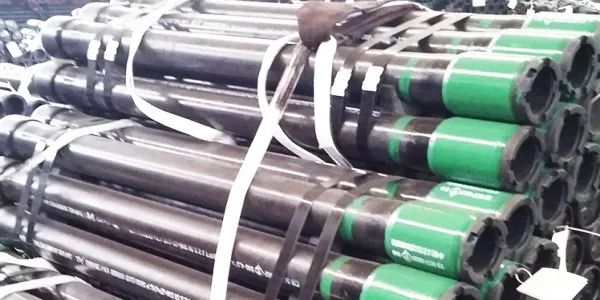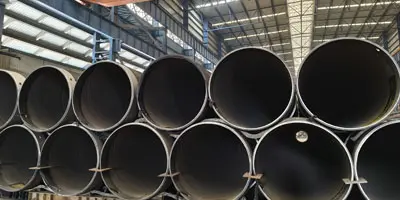Pup joints are essential components in industrial pipeline connections. Common types include threaded
pup joints (double-threaded, single-threaded, and flat-threaded) and flange-connected pup joints. A pup joint is essentially a short piece of tubing; compared to regular tubing, the main difference is its length. Standard lengths include 0.25m, 0.5m, 1m, and 1.5m, and they are used for assembling downhole tubing strings. Pup joints are typically classified into tubing pup joints and casing pup joints.

Types of Pup Joints
Threaded Pup Joints: These include double-threaded pup joints (threads on both ends), single-threaded pup joints (threads on one end), and flat-threaded pup joints.
Flange Pup Joints: These are used with flanges, allowing for flexible alignment during pipeline connections. As long as the flange sizes match, they can be connected at any time.
Tubing Pup Joints: These shorter sections of tubing are available in lengths of 0.25m, 0.5m, 1m, and 1.5m, primarily used for adjusting the length of downhole tubing strings. They have smaller diameters, typically ranging from 2-3/8 inches to 4-1/2 inches.
Casing Pup Joints: These have larger diameters, ranging from 4-1/2 inches to 20 inches, and comply with
API Spec 5CT standards.
End Processing Methods of pup joints
Depending on the end processing method, tubing pup joints can be divided into:
Upset Tubing Pup Joints: These include external upset (EU) and internal upset (IU) types.
Non-Upset Tubing Pup Joints: These are marked as NU.
Common Types of Pup Joints
Standard Pup Joints: Used for adjusting the length of tubing strings.
Double Male Pup Joints: These have external threads on both ends.
Integral Upset Pup Joints: Made with thick-walled materials to enhance strength and durability.
Application and Importance of Pup Joints
Pup joints are widely used in the oil, gas, and chemical industries for drilling and production operations. They serve as short pipe sections, typically ranging from 2 to 10 feet in length, to adjust the length of longer drill pipes or casing strings. The term "pup joint" derives from their relatively shorter length compared to the main sections of the pipe, much like a puppy is smaller than a full-grown dog.
Proper usage of pup joints is crucial for the safe operation and longevity of pipelines. Correct connection methods ensure the seal and stability of the pipeline, minimizing the risk of leaks and accidents.
Correct Usage: Step-by-Step Guide
1.Selection of the Right Pup Joint
Material Compatibility:
Choose a pup joint that matches the strength, grade, and specification of the parent pipe (tubing,
casing, or
drill pipe).
Thread Compatibility:
Ensure that the thread type (e.g., EUE, NUE, BTC, LTC, premium threads) is identical to the adjoining pipe components.
Length Requirement:
Select the appropriate length to achieve the desired string configuration or tool depth.
Pressure and Temperature Ratings:
For high-pressure/high-temperature (HPHT) wells or sour service environments, select pup joints that meet the corresponding standards like NACE MR0175.
2.Proper Installation and Make-Up
Clean and Inspect Threads:
Before connecting, remove any debris, grease, or corrosion from the threads using a brush and solvent. Inspect for any visible thread damage.
Use Thread Compound Properly:
Apply the correct thread compound (API-modified thread dope for API joints or specified compound for premium connections) evenly to the threads.
Apply Proper Torque:
Use a calibrated torque wrench or tong to tighten the joint according to the recommended torque values provided by the manufacturer or API guidelines.
Check for Alignment:
Ensure that the pup joint is perfectly aligned with the rest of the string to avoid bending stresses or misalignment during operation.
3.Pressure Testing
After installation, especially for critical wells, perform a pressure test on the string that includes the pup joint. This ensures the integrity of the connection and that there are no leaks under operating pressure.
4.During Operation
Monitor Vibration and Load:
In drilling or production, keep an eye on string dynamics. Pup joints can be a weak point if subjected to excessive vibration, bending, or pressure cycling.
Avoid Overloading or Buckling:
Do not use pup joints in situations where they bear heavy axial loads unless they’re designed for it. For example, in deep wells, ensure the mechanical properties can handle compressive or tensile stress.
How to Select the Right Pup Joint
Selecting the appropriate pup joint is the first and most critical step. It should not be seen as a filler pipe, but rather as an engineered component:
Match Steel Grade and Wall Thickness: The pup joint must have the same mechanical properties as the main string (e.g., J55, N80, P110 for casing; E75, S135 for drill pipes).
Check Thread Compatibility: The threads should match exactly—whether they’re API standard (e.g., EUE, NUE, BTC, LTC) or premium connections—to avoid leaks or galling.
Length Precision: Choose the length based on the needed spacing between tools or components, or to reach a specific depth.
Application Environment: For corrosive environments (e.g., CO₂, H₂S), consider corrosion-resistant alloys like 13Cr, or select sour-service qualified pup joints meeting NACE MR0175 standards.
The wrong selection may result in uneven loading, poor sealing, or thread failure during operations.
Conclusion
Pup joints play a critical role in the oil, gas, and chemical industries, providing flexible short-distance connections for pipelines. Understanding the correct selection and installation methods for different types of pup joints is crucial for ensuring the safety and durability of pipeline systems. Through proper training and adherence to industry standards, performance can be optimized, and risks associated with pipeline operations can be minimized.






 English
English Español
Español بالعربية
بالعربية











 Phone :
Phone :  Whatsapp :
Whatsapp :  Email :
Email : 


